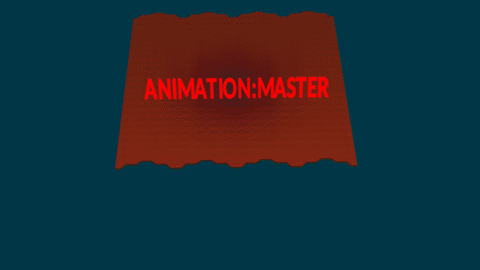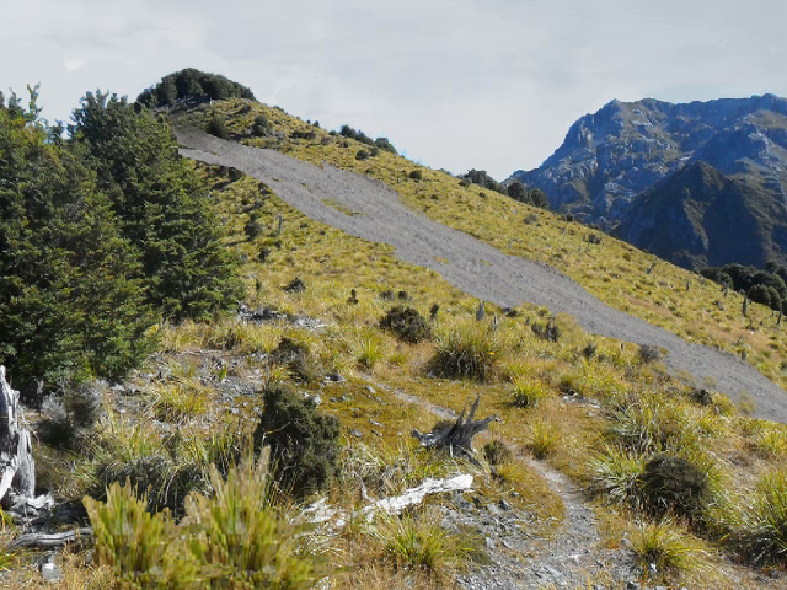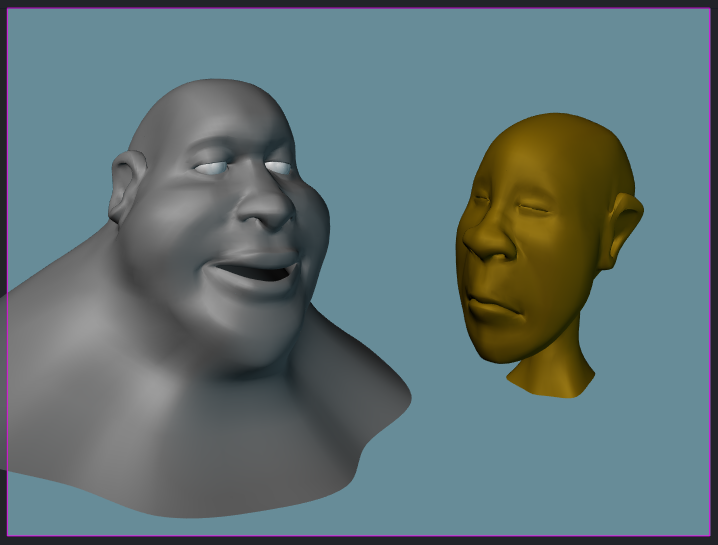-
Posts
21,649 -
Joined
-
Last visited
-
Days Won
119
Content Type
Profiles
Forums
Events
Everything posted by Rodney
-

A character I started working on yesterday
Rodney replied to jirard's topic in Work In Progress / Sweatbox
You should be able to hot link from other sites but the size may make a difference there as well. BUT you don't want to link from another site... because that link is more likely to break or just go away (resulting in sad faces when the topic is read in the far flung future) Uploading as an attachment is the best bet all the way around. -

A character I started working on yesterday
Rodney replied to jirard's topic in Work In Progress / Sweatbox
Size does matter. I'm not sure of the exact size but... whatever that size is... we have to post a size equal to or smaller than that. Then the gif will animate directly in the post rather that be represented by a still image. (All that conversion stuff happens automatically in the background by forum code) I confess that I've gotten lazy with this as the primary program I use to turn sequences into gif animation just lets me specify a shrink value and I know that "4" works and provides a reasonable size. Since the original size in that program defaults to 1920x1080 it would seem that a gif animation of 480x270 should animate in the post rather than be replaced by the still image. Start a new topic and post a few random sizes in that 480x270 range and that will tell the tale! -
Just so we are talking about the same thing... we are talking about the Yeti CD right? Er... maybe not Yeti CD. That looks like 2005 (v12). in looking through my CDs I'm not sure I even purchased the v13 CD as that was when the digital subscription arrived. So I'm not sure I can even test that. Ah, disregard all previous in this post... that'd be the Tin Woodsman CD. I have a fragment of the CD I broke while in Iraq but I've managed to bury the replacement copy somewhere. If/whem I find it I'll test it out.
- 12 replies
-
Some of the earlier versions of A:M had to have a stuff file ran. I can't recall if v13 was one of those but if it was it should be on the FTP site. Edit: Yes, there is a stuff file for v13. Look for it here: ftp://ftp.hash.com/pub/updates/windows/Am2006/ P.S. It's great to see you jon!
- 12 replies
-
It shouldn't. Perhaps we need to investigate the whys and wherefores. I only have something like 11.5GB of acessible working memory and I tend to leave multtiple programs open and dozens of websites unclosed... and Simcloth is still quite responsive. Another thing to keep in mind is that a lot of the texturing, lighting and such can be done after the simulation. So it's a lot like working with group of models. The thing I try to remind myself is that simulation is the first step in creating the resource that will be used later and that often won't require any simulation at all. For instance, I might want to extract two or three frames of a sequence as a background... no need for me to use them all. I will say that the project file I posted is unnecessarily complex so if you have tried that... my apologies as it's a bit large. It's multiple choreographies with fully simulated data.
-

Davinci Resolve (Non Linear Video Editor/Color Correction)
Rodney replied to Rodney's topic in Open Forum
Here's a 20 minute video that walks through many of the new additions and integreations in Davinci Resolve: xhttps://www.youtube.com/watch?v=84e7iCI9Jkk -
The first Choreography in that Project is the results of this quick test wherein the transparent sphere used to break the tiles apart is revealed. The second Chor uses two invisible spheres.
-
Harun's progress in his ToaA:M Journal has me playing with Simcloth and (as per usual) I tend to use the feature for things not intented... Here's an example of Simcloth used to shatter some tiled bricks. And of course that in and of itself was an experiment as well as every tile began as a five point patch (I thought... why not?). I played around with several Simcloth setups and have some ideas in mind for future tests. I feel a bit like our favorite tinkering gnome here. Stop in and check out Harun's work here: https://www.hash.com/forums/index.php?showtopic=48277 Disclaimer: If you do download this file be aware that this project file is a mess. I was testing some rendering options and didn't bother resetting or organizing anything. 5 PointMeshSmash.prj
-
I like that Devil's point sequence... I must assume this is the scene you refer to as being added as I don't recall seeing it before. Looks perilous! So, I'd say in adding that scene you've accomplished your goal. It sounds like you've been jumping through a lot of hoops to achieve these results and your hard work is paying off. (If you want me to photoshop that guy out of that 3rd scene I'd be glad to do it. He's giving me the creeps. hehe That or you could just put a nice deserty bush or rock there.) Added: Something like the attached. If you look closely you can still see him hiding there.
-
Of course, you must do... both. How that shift from color to black and white would depend on how it best fits into your story. The most obvious approach to that would be a vignette at the beginning and end in color with the middle in black and white but I suspect color could be used in a better way. There are a lot of potential approaches and most wouldn't work well. But if you think of color as a character in and of itself that will surely help. I don't know enough about the plot of the story to make an educated guess. Importantly, I do think you should render the whole thing in color... even if you end up presenting the final film in black and white. It's easier to make a color presentation black and white than to make a black and white presentation color. So if you ever need to have elements of it in color.... (I do like the black and white look!)
-

A character I started working on yesterday
Rodney replied to jirard's topic in Work In Progress / Sweatbox
Nice work Matt. Surprise. Surprise. Jirard's models look great animated too! -

Davinci Resolve (Non Linear Video Editor/Color Correction)
Rodney replied to Rodney's topic in Open Forum
I've long sung the praises of Blackmagic Design Fusion and have been interested in Davinci Resolve although I haven't had as much of a need for a high end video editor and color correction suite. BUT... Resolve is about to gain a 3D workspace and it's integration with Fusion are about to take it to the next level. Davinci Resolve 15 Beta 1 is now available: https://www.blackmagicdesign.com/products/davinciresolve/# You don't have to bite yet but do yourself a favor and just start leaning in that direction. Watch a few videos. Start getting familiar with the interface. Explore how you'll integrate Resolve workflow with A:M. -
Fun stuff. For some reason I am particularly drawn to the toy camera being used to manipulate the virtual camera (to include focus). I think it's the element of simplicity combined with practical use (in filmmaking and storytelling) that particularly intrigues me.
-
Having not programmed anything in OpenGL I have to say that I didn't know that but it makes sense. I wish I had a better understanding of it. This is a good example of what I was suggesting in my response to Vong's post. People state an interest but that interest evaporates for a number of different reasons even before the desire is voiced. I was one that added my voice of approval to your Blender add on because the merit of the work was self evident. That and I tested it. But those that clamored for such... where are their voices? The level of real genuine interest from those that state they need these things falls short. As for A:M users (with an emphasis on use) there is going to be less interest because A:M largely supplies what they need right out of the box. And since many/most don't use Blender because it doesn't add significantly to what they need it's hard to support. Those that need to support it are those with the desire to use Blender and other programs with A:M. Again, where are those voices of support? It isn't the A:M users that don't care. They demonstrably do. It is the non users of A:M that say they would use A:M if only this... if only that... but demonstrably will not. I appreciate your Blender to A:M addon because I keep an eye on Blender and periodically download and try it out. I tested your add on and it worked for its intended purpose. But for those who really should care... will such efforts ever be enough? I'm ever the optimist but I must confess that I have doubts.
-
To piggyback off of what Nemyax has said here... In the far flung past OpenGL itself ensured the point based data would be tesselated (into tiny triangles) but that isn't where this thing ends. There is still a rasterization process that determines what data is rendered to pixels on a 2D screen. But lets focus on the initial processs of tessellation first because what happens there defines what flows onward from there. After the initial vertex shader is applied OpenGL dives into tesselation. As of OpenGL 4.0 programmers gained the ability to assign additional vertices as GL patches. So since 2010 programmers were no longer strictly constrained to triangles and strips of triangles. BUT this created a very different and significant problem in continuity of said patches as initially there is no continuity whatsover in these GL patches. The tesselated patches are individual quad primitives with no knowledge of their adjacent patches. But let's move on for a moment because there are other inequalities to consider. For instance, it is important that processing reduce variation as much as possible because according to the OpenGL spec: Emphasis added Therefore the reading of the OpenGL spec is highly recommended when considering OpenGL implementation and upgrades to those configurations. Ref: https://www.khronos.org/registry/OpenGL/specs/gl/glspec45.core.pdf#page=657 Added: The lack of continuity in rendering isn't particularly problematic because the blending process of color shaders makes everything appear to be smooth and continuous. Where we run into problems is with animation in that those surfaces must be interpreted and manipulated by various means generally not equivalent to animating with splines and patches. On the plus side, there have been tremendous gains on this in the animation industry of late. I do like how the OpenGL spec states the following as if they have a good sense for priority: Of course those of us that use A:M would very likely prefer the term 'spline' over 'line segment' but the are largely the same thing. It might not be immediately apparent but in that sentence they are saying point, line, patch (or polygon). The last of those three elements being the one of notable preference; patches or polygons.
-
Looks to me like the difference is mostly texturing and lighting. As long as I've been using A:M we have always been able to export a model out and texture and light it in other programs. It's those other programs getting into A:M that has been the problem. (the sows ear to silk purse analogy)
-
Vong, Even if such a thing were possible I remain unconvinced and would guess that those in a position to fund such an important endeavor would be even less convinced. The promise of a return rings hollow although it's certainly something I'd love to see. It would go a long way to convince me personally if even a small number of those 'quite a few' were to demonstrate their stated interest and as a show of good faith simply purchase a one year subscription to A:M to demonstrate their desire to see A:M succeed. The worst that would happen is those devotees would spend $79 on a program they sincerely want to see succeed and that they hope some day will incorporate the features they need. This will not happen. We know that polygon/sub-d integration isn't important to those you speak of because as fellow A:M Users we have all seen and experienced their lack of interest first hand. And unfortunately this is the underlying reality of that particular pipedream. Perhaps if we start with one of those old friends and colleagues the ball will start rolling. Gotta start somewhere! In case folks have forgot the URL feel free to share the link: https://www.hash.com/store/
-
Nice! And just in time for the production of your short film!
-

A character I started working on yesterday
Rodney replied to jirard's topic in Work In Progress / Sweatbox
You definitely have the knack for modeling heads/faces. Nice work! Your 'half done' surpasses my 'fully done' by a considerable margin. -

(Solved) Are there any A:M users here in the Philadelphia PA area?
Rodney replied to Mechadelphia's topic in Open Forum
It'll be good to see you more often here! I've often bemoaned the fact that there are few A:M users locally but then I see the same lack of interest for computer character animation from any approach too. And then to compound the matter there is a dearth of interest in other creative endeavors that align with that also. My theory is that a lot of the interest that is there is largely superficial and follows the path of consumers rather than creators although I realize that might apply to me just as well as anyone else. We often get inspired by what we see and experience but lose interest when the going gets rough and work must be done. You represent someone with the patience (and insight) to rig characters and that sets you even further apart. While a bit lonely... at least on the plus side... that's a great problem to have. All the more reason to hang out here in the A:M Forum with each other. Also: I don't want to downplay the importance of getting together in person wherever and wheever we can. I do wish we could do that more often. If you get the chance you should drop in on Saturday Live Answer Sessions. It's not quite the same as being there in person but it's a close second. Those sessions only last an hour (which is a good thing so people don't get burnt out) but nothing says folks can't still hang out together thereafter. -
Here's the basic usage video: xhttps://www.youtube.com/watch?time_continue=11&v=U6wtw6W4x3I
-
Thanks for the heads up on the first link. It apparently had the closing bracket included in the URL. The URL just takes you to the documentation of the method and that link is available via the download site also. Some of that depends on flow and continuity which will produce that economy and the user should be able to specify. Use the brush tool and then paint the preferred flow directly on the model and the subsequent retopologizing will follow. As for patch density I think the default target for density is set way too high for our needs although that might work well in other programs. That default was 999 or something and dropping it to 300 worked pretty well on a simple model.
-
Here's a free program that might be useful for those that want to get at quad based topologies quickly. It's based on fairly recent paper about 'instant field aligned meshes' (Link to project page here: http://igl.ethz.ch/projects/instant-meshes/ Binary files are available for Windows, Mac and Linux here as is the source code: http://igl.ethz.ch/projects/instant-meshes/ The quick tests I did turned out quite good. DIsclaimer: Don't think this will keep your textures mapped.... it won't as it's not that kind of program but rather one that works deeply on topology.
-
Some of you may recall Jeffrey Dates 'Day Off the Dead' short from many years ago when he was an avid A:M user. Like many others Jeff used his time with A:M to move into the animation industry and is still quite active in animation. He has been working for The Mill of late and their efforts at The Mill to promote real time character animation has recently made the news https://www.cartoonbrew.com/vfx/how-the-mill-is-embracing-real-time-for-character-animation-157603.html
-
- 1
-

-

A character I started working on yesterday
Rodney replied to jirard's topic in Work In Progress / Sweatbox
Agree. Very nice character with great personality built right in to the splinage. Nicely done.












